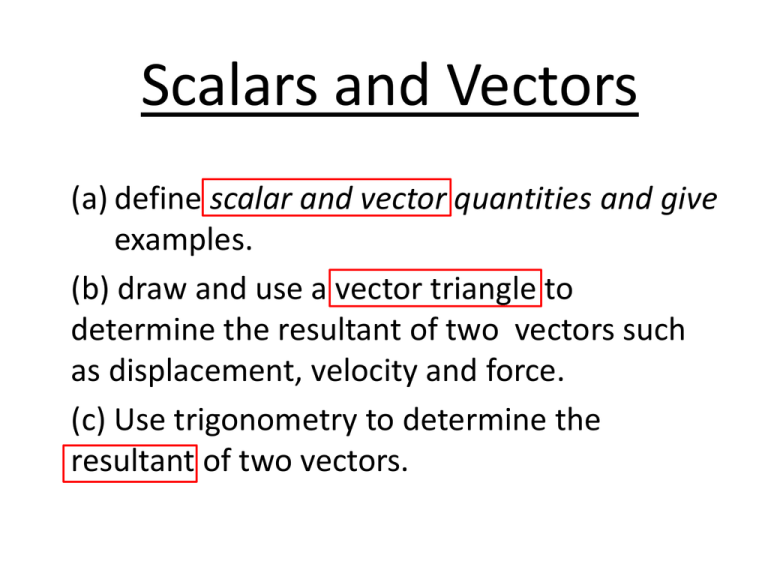Scalars and Vectors - the Redhill Academy
advertisement

Scalars and Vectors (a) define scalar and vector quantities and give examples. (b) draw and use a vector triangle to determine the resultant of two vectors such as displacement, velocity and force. (c) Use trigonometry to determine the resultant of two vectors. Scalars and Vectors Scalar Quantities – A quantity with magnitude but no direction Vector Quantity - A quantity with magnitude and direction ( can be represented on a diagram by an arrow ) mass , displacement, force, length, acceleration, speed, velocity, energy, momentum, time, temperature. Scalars and Vectors Vectors acting in the Same Direction Liam walks 100m due North and then 20m due south. He has walked 120m but is not 120m from his starting point – how far is he from his starting point? 20m Due South 100m Due North Now add Tip to Tail = 80m Due North Scalars and Vectors Vectors acting in a different Direction Liam walks 100m due North and then 40m due East. He has walked 120m but is not 120m from his starting point – how far is he from his starting point ( his displacement)? 100m Due North 40m Due East Now add Tip to Tail = Scalars and Vectors Vectors acting in a Different Direction Use a scale drawing or Pythagoras to find the resultant displacement 40m Due East 100m Due North Scalars and Vectors Vectors acting in a Different Direction Use trigonometry to find the bearing. 40m Due East 100m Due North Tan Θ = 40/100 =0.4 Θ = 21.8 o Scalars and Vectors Vectors acting in a Different Direction Aircraft and a cross wind The next example of vector addition shows an aircraft flying on an initial bearing of 0o at 350 ms-1 with a wind blowing west-east at 50 ms-1. Wind blowing west-east (bearing 270o)at 50 ms-1 Aircraft flying south-north (bearing 0o) at 350 ms-1 Scalars and Vectors 50 m/s Wind blowing west-east at 50 ms-1 350 m/s Aircraft flying south-north (bearing 0o) at 350 ms-1 Scalars and Vectors 50 m/s 350 m/s Scale Diagram 50 m/s 350 m/s Trigonometry Final path of aircraft is N 8.1o E moving with a speed of 354 ms-1 Scalars and Vectors 50 m/s 350 m/s Scale Diagram 50 m/s 350 m/s Trigonometry Final path of aircraft is N 8.1o E moving with a speed of 354 ms-1 Scalars and Vectors By the end of the lesson you should be able to; • Resolve a velocity vector into two perpendicular components. • Apply the equations of constant acceleration to describe and explain the motion of an object due to a uniform velocity in one direction and a constant acceleration in a perpendicular direction. Scalars and Vectors Resolving vectors Scalars and Vectors What is similar and what is different for these two projectiles ? Scalars and Vectors Resolving vectors Scalars and Vectors How does resolving vectors help us to analyse projectile problems? Vertical Motion Scalars and Vectors How does resolving vectors help us to analyse projectile problems? Horizontal Motion Scalars and Vectors How does resolving vectors help us to analyse projectile problems? Jan 07 v = u +at Jan 03 V2 = u2 +2as June 08 S= ut + ½at2 g = 9.81ms-2








